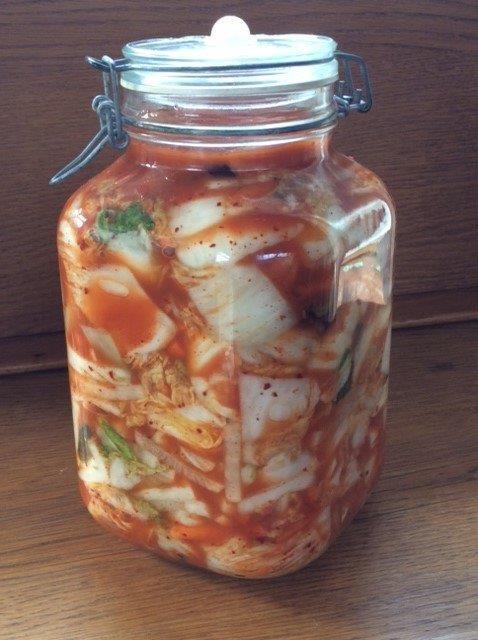
How to Make Kimchi
Ingredients:
- 1 medium head (1 kg) Chinese cabbage (AKA Napa or Wombok)
- 1/4 cup sea salt or kosher salt (see Recipe Notes)
- 1 tablespoon grated garlic (5 to 6 cloves)
- 1 teaspoon grated ginger 1 teaspoon sugar (optional)
- 1 grated Nashi pear (optional)
- A little paste made from glutinous rice flour and water (optional) -put in saucepan on stove and cook stirring all the time – it will quickly make a sticky paste
- 2 tablespoons fish sauce* (Red Boat brand is good) – Optional -see Recipe Notes
- 1 to 5 tablespoons Korean red pepper flakes (Gochugaru- available from Korean supermarket)
- 225g Korean radish or daikon, peeled and cut into matchsticks
- 4 scallions/spring onions, trimmed and cut into 2 cm pieces
Instructions
- Slice the cabbage: Cut the cabbage lengthwise into quarters and remove the cores. Cut each quarter crosswise into 4-5 cm wide strips.
-
Salt the cabbage: Place the cabbage and salt in a large bowl. Using your hands massage the salt into the cabbage until it starts to soften a bit, then add water to cover the cabbage. Put a plate on top and weigh it down with something heavy. Let stand for 1 to 2 hours.
-
Rinse and drain the cabbage: Rinse the cabbage under cold water 3 times and drain in a colander for 15 to 20 minutes. Rinse and dry the bowl you used for salting, and set it aside to use in step 5.
-
Make the paste: Combine the garlic, ginger, sugar, nashi pear, glutinous rice paste and fish sauce* in a small bowl and mix to form a smooth paste. Mix in the gochugaru, using 1 tablespoon for mild and up to 5 tablespoons for spicy (I like about 3 1/2 tablespoons).
-
Combine the vegetables and paste: Gently squeeze any remaining water from the cabbage and return it to the bowl along with the radish, scallions and seasoning paste.
-
Mix thoroughly: Using your hands, gently work the paste into the vegetables until they are thoroughly coated. The gloves are optional here but highly recommended to protect your hands from stings, stains, and smells!
-
Pack the kimchi into the jar: Pack the kimchi into the jar, pressing down on it until the brine rises to cover the vegetables. Leave at least 2cms of headspace. Seal the jar.
-
Let it ferment: Let the jar stand at room temperature for approx 1 week. You may see bubbles inside the jar and brine may seep out of the lid; place a bowl or plate under the jar to help catch any overflow.
- Check it daily and refrigerate when ready: When the kimchi tastes ripe enough for your liking, transfer the jar to the refrigerator. You may eat it right away, but it's best after another week or two.
Recipes Notes
Salt: Use salt that is free of iodine and anti-caking agents, which can inhibit fermentation.
Water: Chlorinated water can inhibit fermentation, so use spring, distilled, or filtered water if you can.
Seafood flavour and vegetarian alternatives: Seafood gives kimchi an umami flavour. Different regions and families may use fish sauce, salted shrimp paste, oysters, and other seafood. Use about 2 tablespoons of fish sauce, salted shrimp paste, or a combination of the two. For vegetarian kimchi, you could use 3/4 teaspoon kelp powder mixed with 3 tablespoons water.
